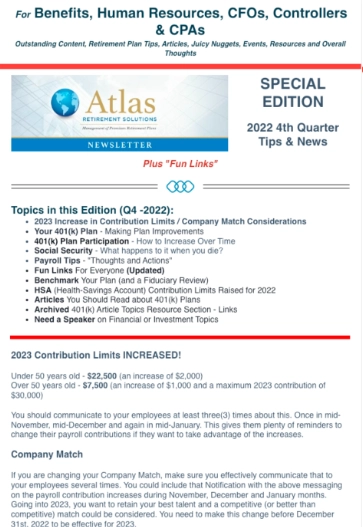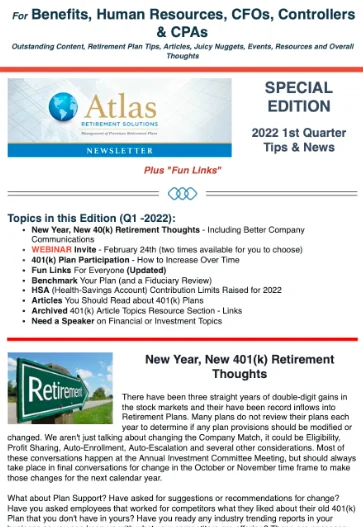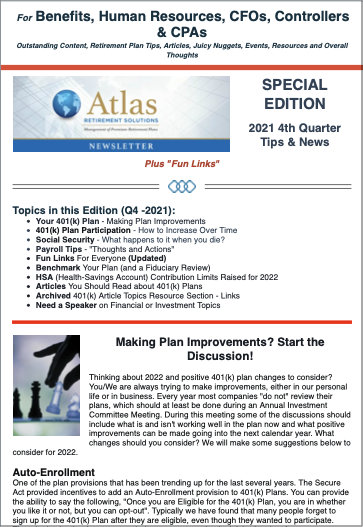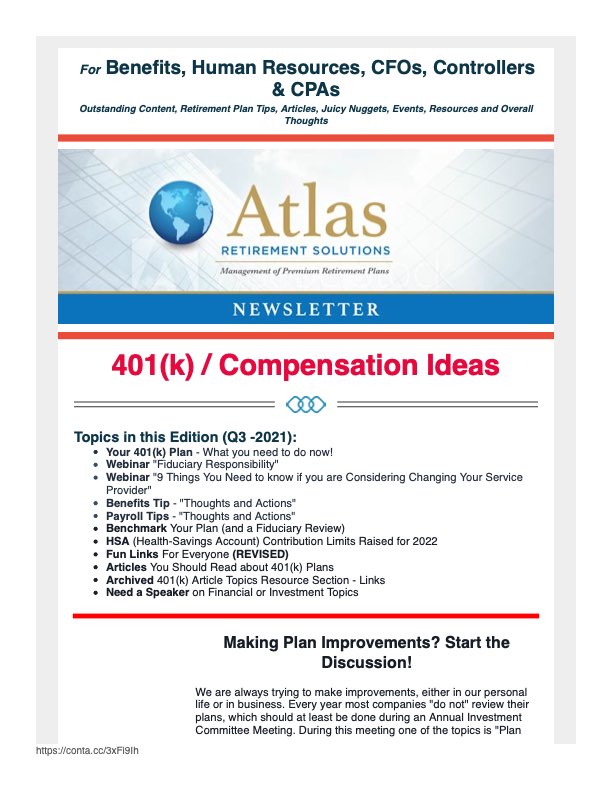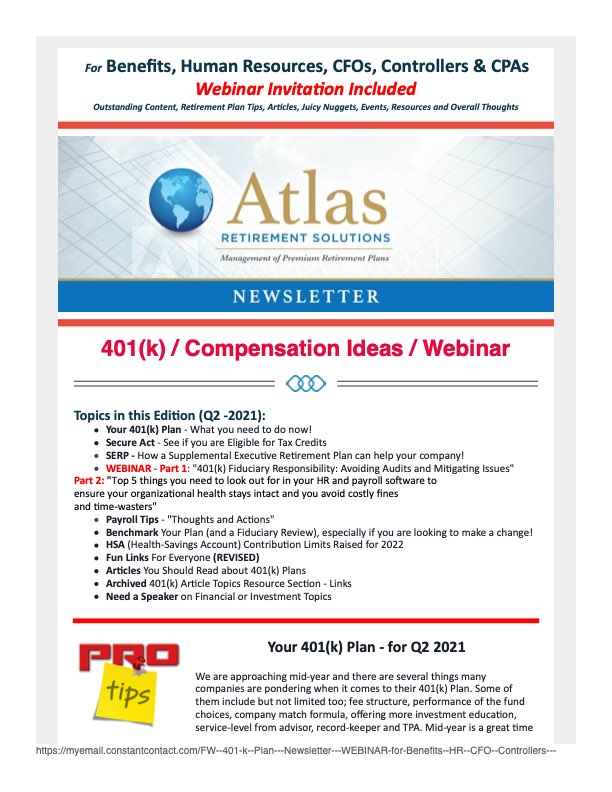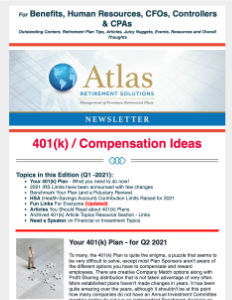This article will be in four(4) separate parts and focus on key areas of the 401(k) Plan that the biggest MISTAKES are made and ideas on how to fix them. We are providing this information almost as a “How-To” playbook on achieving 401(k) Plan success and avoiding a potential DOL audit.
Offering a 401(k) Plan to your employees is important. Remember, a successful 401(k) Plan is meant to Attract, Retain, Reward and Motivate employees. In many situations by not offering a 401(k) plan as a benefit, you may not be able to attract the right talent and have them accept an offer. Retirement savings are probably at crisis levels for being on-track to retire comfortably and hopefully not live off just the principal.
The 401(k) plan structure can make or break the success of the plan and good attention to detail will help. For example, there are life cycles to a business and as a business needs adapt to client needs, economic cycles, technology and innovation, the needs of the participants need to adapt too. Failing to recognize this as an important factor breed’s ambiguity to the plan and the participant’s requirements to become “retirement ready”.
The plan structure is essentially created in the “Adoption Agreement” of the 401(k) plan. It outlines all the rules, regulations and policies of the plan. Any changes to the plan, the Adoption Agreement has to be modified and provide notifications to all participants. But this document should be reviewed annually to make sure it’s meeting or exceeding the needs of the company and the participants. We will review several ideas on plan structure that you could consider and modify in your Adoption Agreement immediately if it makes sense.
Any company can help relieve a lot of 401(k) plan stress through several simple steps.
First, you need to offer a 401(k) Plan with flexibility so it can accommodate several different savings methods, reward tenure and hopefully offer a match program.
Second, be very cognizant of fees! Both at the Administrative and Participant levels. This is typically the number one potential red flag for a DOL audit. We will address this in a future part of this article.
Third, Provide quality and consistent Education to all participants. Details on a solid Education plan will be outlined in a future part of this article.
Fourth, encourage all eligible participants to participate in the plan and emphasize relieving future retirement stress.
Part One – 401(k) Plan Structure Mistakes and Ideas on to Fix them
Many companies do not receive proper plan consulting or decide they want the “no frills” plan and go for a simple on-line program which typically offers some help at the Plan Sponsor level, but very little or no help at the participant level. If you do not have the background or knowledge for a 401(k) Plan Structure setup, relying on the lowest cost provider can end up costing you a significant amount in the future. This can affect you with higher fees, complaints from participants, possible DOL audits, potential 5500 Form Filing issues and loss of potential and current talent in the company.
With your current plan, “you may not know, what you don’t know”. Meaning that you may have only relied on a potential “trusted source” at the time. It could have been your company’s CPA, Investment Advisor, Networking contact, on-line search results or even your neighbor. They may be all good people in your life, but not necessarily experts on 401(k) Plans. You may have heard of the following adage; “a good business experience you may tell 1-2 people, one bad business experience you will probably tell 8-10 people about it.” Many times you learn significantly more from people with bad experiences than good experiences, even though their business situation may be different than yours you can still identify what can be potentially good or bad for your 401(k) Plan.
Idea #1
Your current plan may have worked for you 3, 5 or more years ago, but what about now? When was the last time someone sat down with your executive team to review the plan, understand what has changed with your business, garnered feedback from your participants and tried to incorporate the plan to compliment your compensation plan? All are very important questions, if you can’t answer them, address immediately. At the minimum, this should be done annually at the Investment Committee meeting.
Idea #2
Flexibility! Did you know that you could offer a Roth 401(k) option? It’s been available since 2006 and is a terrific option to those who do not want to pay taxes on retirement savings after 59 ½. Even though they don’t get the pre-tax benefit now, many participants want this option. Some people like this as a hybrid option to coincide with their traditional 401(k) pre-tax plan.
Idea #3
General Flexibility such as “Withdrawals and Hardship”. Despite the fact that most participants may never take advantage of these options, just offering them as part of the plan makes it attractive as a just-in-case situation or an emergency option. Those that use the Withdrawals and Hardship Loans more than once probably should not be contributing to a 401(k) plan, despite the encouragement to save for retirement. By using one of the options more than once, their financial situation could be more dire than expected and their savings rate may not be at a desired-level.
Idea #4
In-Service Distributions are much different than a “Withdrawal or Hardship Loan” because many times this money is moved to a “self-directed” account (i.e. rolled over) and managed directly by the participant. This is done for several reasons. First, it could be due to the lack of good asset options in the company plan or its poor performance and high fees. A self-directed IRA provides the flexibility to invest in other options perhaps more geared towards their investment strategy and risk profile. Second, they could use a portion of that retirement account to protect the principal and have growth potential through a low cost, Fixed-Indexed Annuity (FIA). This is becoming a more popular option because many 401(k) plans are rigid in nature and have a closed plan architecture that prevents having a flexible asset lineup. In-Service Distributions are just another option even though less than 10%-15% of participants may actually take advantage of it. Of course, the more flexible the asset lineup is for diversification, solid performance and reasonable fees, the less chance the participant would actually need or consider an In-Service Distribution.
Idea #5
Retaining employees is always important as the “war for talent” becomes fiercer. Obviously through creative compensation plans, enjoyable work environment along with solid management, you have a better chance at retaining great employees. One way to reward tenure in a company and to encourage tenure is through a “Stepped-Up Match Program”. This offering provides a greater Company Match to those participants as their tenure increases. For example (sample only), your company match will increase based upon each range break in the number of years of service; 1-5 years, 2% Match; 6-10 years, 3% Match, 11-15 years, 4% Match, 16+ years, 5% Match. Obviously, you can setup your own range breaks and match that makes sense to your business and profitability. You may be surprised how much this can help a maturing company to retain and reward talent and tenure. You can see the benefit of this and the longer the company is solvent, building its brand and wants to keep its top talent, this is just another great incentive to reward those participants.
Idea #6
A “Vesting Program” for Profit-Sharing in the 401(k) Plan can be a tremendous incentive for participants. As you know any participant can have an additional $35k in Profit-Sharing in additional to their $18k annual contribution (plus $6k over 50 catch-up) in a combination of Company Match plus any additional Profit-Sharing the company sees fit to offer. For example, the company may decide to reward an individual with a $12k Bonus with a 6-year Vesting Schedule. This means every year they will get an additional $2k added to their 401(k) from the company. Another terminology for this is “Golden Handcuffs” as someone may debate leaving a company because they have so much “unvested” money that they may want to wait or not leave because they would risk losing that money unless the situation was untenable.
Idea #7
Setup an Investment Committee that meets with the 401(k) Service Provider every year to review the plan design and asset lineup. This will help with your Fiduciary Responsibility (which will be discussed in a later part of this article). This meeting is critical to your success and helps by reducing your risk of a future DOL audit.
Idea #8
Many plans have a “Closed Architecture” and a rigid design structure that cannot be changed, specifically the “asset lineup”. You should request or demand an ”Open Architecture”. This allows you to offer more choices or funds or preferably a complete lineup of ETFs. Typically ETFs, which are essentially a Mutual Fund that trades like a stock have similar or better performance than an equivalent Mutual Fund and usually has less fees. This helps the participant in the long run with greater performance on the assets they choose because their asset fees are not eating away at the performance. An “Open Architecture” also gives you the flexibility to implement one or more of all the ideas presented in this article. The “Open Architecture” gives you and your company the flexibility to accommodate your situation today and in the future without limiting options to the company and participants.
In summary, of course you would agree that flexibility to a plan is critical to its success, but are you ready to accept changes. My typical suggestion to anyone that we are first getting started with is to create a “Participant Survey” with no more than 5 – 7 questions that takes less than five minutes to answer. This feedback is critical to a successful plan and adoption rate, typically known as “Participant Rate”. We normally identify 80% as our goal for each plan and if you are less than 50%, problems typically exist in those plans.
Many times the 401(k) is not a priority over business development and retention, but a necessary task for all the other reasons in Part One and future parts of this article. We wish you the best and to your future 401(k) Plan success and achieving the rest of your business goals.
Authored by
Ronald E. Lang, Principal
Atlas Wealth Management, LLC
401(k) Service Providers
(888)403-9400
Ron.Lang@AtlasBuildsWealth.com

